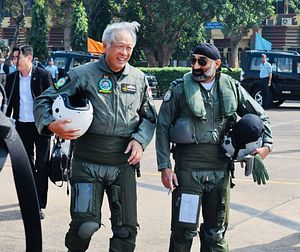On November 27, Singapore’s Defense Minister Ng Eng Hen paid a visit to India for a series of engagements, including the second iteration of their new defense ministers’ dialogue mechanism. Ng’s trip put the spotlight on an aspect of the relationship that has made gradual progress over the past few years.
India and Singapore enjoy a close defense relationship. Apart from usual interactions such as exchanges, visits, and exercises, India is also on the list of countries that allows the Singapore military to train on its own soil, which is critical for the city-state due to space constraints. Beyond just the bilateral frame for ties, Singapore views India as one of a series of major powers to engage in the broader context of the Asia-Pacific. New Delhi sees the city-state as an important actor to engage in the region and within Southeast Asia more specifically as part of its Look East Policy, which has been publicly articulated since the 1990s before being rebranded as “Act East” under Prime Minister Narendra Modi.
Defense ties have been gradually growing over the past few years. In November 2015, in an important step, the two sides agreed to an annual Singapore-India Defense Ministers’ Dialogue (DMD) as part of an upgraded Defense Cooperation Agreement (DCA) first inked in 2003 as they commemorated the 50th anniversary of their defense relationship. As I had written previously, the first DMD was successfully held in June 2016 ahead of the Shangri-La Dialogue (SLD), Asia’s premier security forum (See: “Singapore, India Hold First Defense Ministers’ Dialogue”).
Defense ties between the two countries and within the broader India-Southeast Asia realm are expected to be a focus as well next year, with Modi delivering a keynote speech at the SLD during the year that Singapore will hold the annually rotating chairmanship of ASEAN and India hosting all ASEAN ministers for a special meeting in New Delhi, as the regional grouping has been doing with several of its dialogue partners over the past few years.
On November 27, Ng began his visit to India for a number of defense-related engagements as well as to co-chair the second India-Singapore Defense Ministers’ Dialogue together with his Indian counterpart Nirmala Sitharaman. Ng was accompanied by several defense officials, including Chief of Navy Rear Admiral Lew Chuen Hong, in a trip that lasts until November 29.
As expected, one of the highlights of Ng’s trip, apart from the Dialogue itself, which will take place on November 29, was a visit to the Republic of Singapore Air Force (RSAF)-Indian Air Force (IAF) Joint Military Training at Kalaikunda Air Force Station in Kolkata, which is a concrete manifestation of the defense relationship.
The RSAF and IAF joint military training occurs under the Air Force Bilateral Agreement that both sides renewed in January 2017, and this year’s JMT saw Singapore deploy six F-16 C/D fighter aircraft to train with the IAF’s Su-30 fighter aircraft. Ng viewed the RSAF F-16 and the IAF Su-30 fighter aircraft as well as the air exercise as part of his visit there, and interacted with some of the personnel, including around 100 from the RSAF currently there.
But the interaction that made the headlines was Ng’s 45-minute flight on the Tejas, the first indigenously developed light combat aircraft in India. Ng was the first known individual from outside India to fly in the Tejas, and following the flight he was full of praise for the capability of the plane as well as the smooth flight by the pilot.
Ng also later spoke at Brookings Institution India Center about India-Singapore security ties in a changing regional and global environment. In his speech, Ng framed bilateral defense ties broadly in terms of the history of ties between India and Singapore and New Delhi’s role in the region, and noted the importance of collaboration in areas like freedom of navigation while doing so in a way that is not perceived as provocative.
But he also previewed some of the deliverables that we could see formally announced tomorrow as he has his meeting with Sitharaman for the India-Singapore Defense Ministers’ Dialogue and gets to the end of his trip. These include an agreement with the Indian Navy on logistics support and live-firing exercises in the Andaman Sea. All this suggests that Singapore-India defense ties will continue to be a key relationship to watch in the coming days and months into 2018.

































